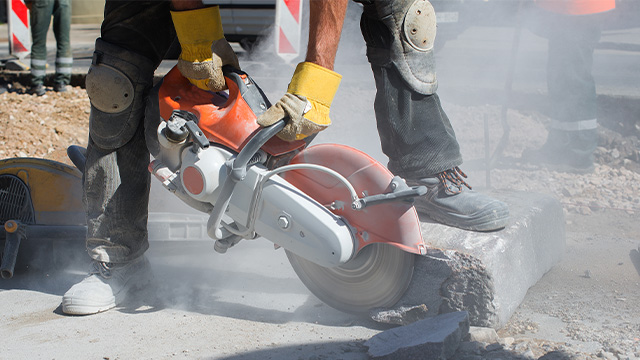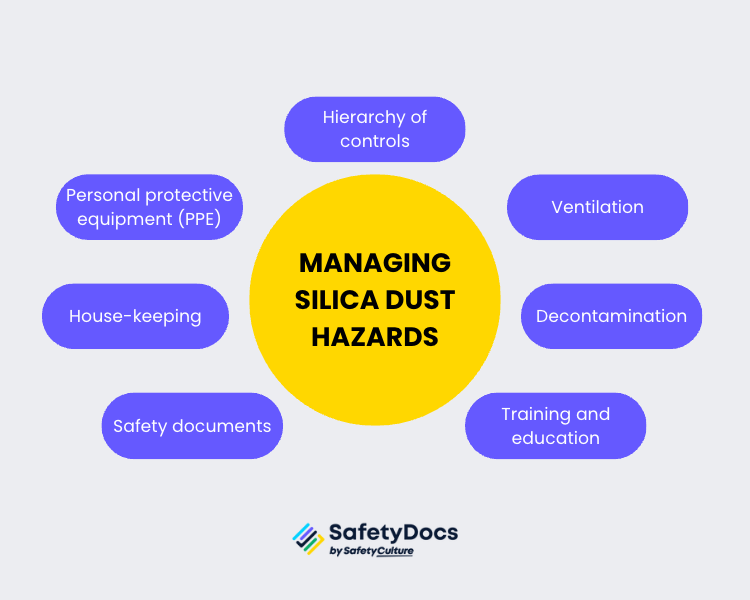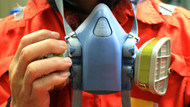Zach Smith, National Secretary of the CFMEU, said engineered stone is the 'asbestos of the 2020s'. There's a truth to this statement since working with engineered stone releases crystalline silica dust in the air. They are extremely dangerous and can cause serious health issues like lung cancer, silicosis, and other respiratory diseases.
In today's fast-paced world, we often focus on visible dangers and hazards that we can easily see and avoid. However, some of the most dangerous threats to our health and wellbeing lurk in the shadows, invisible to the naked eye. One such hazard, frequently found in various industries and workplaces, is respirable crystalline silica (RCS).
This insidious, microscopic menace poses a significant risk to millions of workers across the globe, contributing to severe and life-threatening health conditions such as silicosis, lung cancer, and chronic obstructive pulmonary disease (COPD). Despite its potential for harm, many people remain unaware of the true extent of the problem and the preventative measures they can take.
In this blog, we will shed light on the hidden danger of respirable crystalline silica, exploring its sources, health risks, and the vital steps employers and employees can take to protect themselves and their coworkers. Whether you work in construction, mining, or manufacturing, or simply want to better understand the impact of RCS on our society, this blog will provide you with valuable information to help you navigate the world of workplace safety and health.
What is Crystalline Silica?
Crystalline silica is a type of silicon dioxide mineral that is present in many natural and man-made materials. It exists in two forms: non-crystalline and crystalline. The most common type is quartz (CAS 14808-60-7).
The amount of silica present in different rocks and rock products can vary. For example, marble and limestone typically contain about 2% silica. Natural sandstone can have as much as 95% silica, while engineered stone can contain up to 97%.
What is Respirable Crystalline Silica (RCS)?
Respirable Crystalline Silica (RCS) refers to the microscopic particles of crystalline silica that become airborne during activities that involve cutting, grinding, drilling, or crushing silica-containing materials. Crystalline silica is a common mineral found in materials such as sand, stone, concrete, mortar, and engineered stone.
The term "respirable" indicates that these particles are small enough to penetrate deep into the lungs when inhaled. RCS particles are generally less than 10 micrometres in diameter, which allows them to bypass the body's natural defence mechanisms and lodge themselves in lung tissue. This can lead to various serious health problems over time.
Exposure to RCS is a significant occupational health hazard, particularly in industries such as construction, mining, manufacturing, and foundry work. Prolonged and unprotected exposure to RCS can result in various respiratory diseases and conditions, including silicosis, lung cancer, chronic obstructive pulmonary disease (COPD), and kidney disease. To mitigate the risks associated with RCS, it is essential for employers and workers to follow proper safety guidelines and regulations, including the implementation of effective control measures and monitoring exposure levels.
Is Crystalline Silica Dust Toxic?
Yes, crystalline silica dust is toxic. According to a Curtin University report, an estimated 10,000 Australians will develop lung cancer due to exposure to silica dust. This devastating statistic highlights the dangers of crystalline silica dust. It can lead to the development of lung diseases such as silicosis, lung cancer, and chronic obstructive pulmonary disease (COPD).
Listed below are the health effects of silica dust exposure:
Silicosis
Silicosis is an incurable respiratory disease caused by inhaling silica dust. It causes shortness of breath, coughing, chest pain, and fatigue.
- Acute silicosis: Occurs after a short exposure to high levels of silica dust, leading to severe inflammation and protein outpouring into the lung.
- Accelerated silicosis: This can develop after moderate to high levels of silica dust exposure for 3 to 10 years, leading to inflammation, protein in the lung, and lung scarring (fibrotic nodules).
- Chronic silicosis: This can occur after long-term exposure to lower levels of silica dust, leading to fibrotic nodules and shortness of breath.
- Progressive massive fibrosis: This is a severe form of chronic silicosis where the fibrotic nodules in the lung aggregate.
Bronchitis
Bronchitis is a lung condition caused by inflammation of the airways in the lungs. The cause is typically an infection or exposure to irritants like silica dust. Symptoms include wheezing, shortness of breath, and coughing.
- Chronic bronchitis: This is a form of chronic obstructive pulmonary disease (COPD) that can be due to long-term exposure to silica dust. Symptoms include increased mucus production and a persistent cough.
Lung Cancer
Exposure to crystalline silica dust can increase your risk of developing lung cancer. Symptoms include coughing up blood, chest pain, and shortness of breath.
Emphysema
Emphysema is a lung condition caused by damage to the lungs' alveoli (air sacs). The causes can be smoking, air pollution, or exposure to silica dust. Symptoms include shortness of breath and a persistent cough.
Kidney damage
Silica dust exposure can also cause kidney damage. It can lead to the formation of kidney stones and a decrease in kidney function. Symptoms include abdominal pain, blood in the urine, and nausea.
Scleroderma
This is a disease of the connective tissue in the body that can result in the formation of scar tissue in the skin, joints, and other body organs. The cause is due to long-term exposure to silica dust. Symptoms include skin thickening, joint pain, and stiffness.

Workplace Activities With High Exposure to Silica Dust
Crystalline silica is widely used to create several essential household items. They are used to fabricate kitchen and bathroom bench tops and to make bricks and tiles. In addition, certain plastics contain small amounts of silica to provide greater strength and durability than a standard plastic item.
The following work activities are more examples of work activities that may generate respirable silica dust particles:
- Sandblasting
- Tuck-pointing/bricklaying
- Concrete cutting, drilling and grinding
- Demolition of concrete structures
- Mining and tunnelling operations
- Stone masonry and tile-setting
- Stone crushing and gravel screening
- Manufacturing of abrasive products
- Milling or grinding of cast iron, stainless steel or other metals containing silica.
- Pottery making
Compliance with Silica Dust Regulations in Australia
Silica dust exposure is subject to rigorous regulatory requirements to ensure workers' health and safety. Employers must adhere to the Workplace Health and Safety (WHS) regulations in their respective States/Territories. This includes compliance with the following:
WHS Duties under the Code of Practice
While most states have codes of practice for managing the risks of respirable crystalline silica from engineered stone in the workplace, Queensland's Industrial Relations Minister Grace Grace has given the green light to Queensland's latest Managing Respirable Crystalline Silica Dust Exposure in Construction and Manufacturing of Construction Elements Code of Practice 2022
This Code is the first to specifically address silica dust in the construction sector, and is set to be implemented in Queensland starting May 1, 2023. The Code encompasses all construction activities and the production of materials like bricks, blocks, tiles, mortar, and concrete.
A code of practice provides practical guidance to achieve the standards of health, safety, and welfare required by the Work Health and Safety (WHS) laws. Duties under a code of practice typically apply to different stakeholders, including persons conducting a business or undertaking (PCBUs), workers, and other relevant parties.
Workplace Exposure Standard (WES)
The Workplace Exposure Standard (WES) is a set of values to ensure safe working conditions for workers exposed to hazardous substances. The WES values have three categories depending on the substance's critical effect type.
- Time Weighted Average (TWA): This measures the average concentration of a substance in the workplace over an 8-hour day and 40-hour week.
- Short-Term Exposure Limit (STEL): This is the maximum concentration of a substance that a worker can be exposed to for an average 15-minute period over a day without any adverse health effects.
- Peak Limitation (peak): This is the maximum concentration of a substance that a worker can be exposed to for a short period, such as 10 minutes.
The regulations state that persons conducting a business undertaking (PCBUs) must comply with the exposure standard. They must not exceed 0.05 mg/m3 (eight-hour time-weighted average). Furthermore, they must take all reasonable steps to:
- Ensure that workers don't exceed this standard
- Monitoring air quality using safe work practices
- Provide employees with adequate protective equipment
Air Monitoring
Air monitoring helps to determine the concentration of airborne respirable crystalline silica (RCS) to ensure that it does not exceed the relevant exposure standards.
According to the Work Health and Safety (WHS) Regulations and guidelines from Safe Work Australia, air monitoring should be conducted when:
- There is uncertainty about the levels of respirable crystalline silica exposure and whether they are within the exposure standards.
- There have been significant changes to work processes, control measures, or the type of materials being used, which may impact the level of exposure to RCS.
- The effectiveness of implemented control measures needs to be evaluated.
The purposes of air monitoring are to check the following:
- Effectiveness of control measures
- Inform workers about their exposure patterns
- Determine what level of respiratory protection is necessary
- Inform health monitoring requirements.
However, air monitoring alone does not prevent illness, and effective control measures must accompany it. The air monitoring should also be carried out by a competent person, such as an occupational hygienist, using the appropriate sampling and analytical methods.
Health Monitoring for Workers
In Australia, health monitoring is required for workers who may be exposed to silica dust in accordance with the Work Health and Safety (WHS) Regulations. Health monitoring aims to identify any adverse health effects due to exposure to hazardous substances, including crystalline silica. It is the responsibility of the person conducting a business or undertaking (PCBU) to provide health monitoring to workers who are at risk.
According to Safe Work Australia's guidelines, health monitoring should be initiated for workers when:
- There is a significant risk to the worker's health due to exposure to respirable crystalline silica.
- The worker is working with materials that contain crystalline silica and exposure standards are likely to be exceeded.
Health monitoring typically includes:
- A review of the worker's work history and a medical examination, including a chest x-ray and lung function tests.
- Regular ongoing assessments and follow-ups, as recommended by the medical professional.
Always check with the relevant WHS authority in your jurisdiction for the most up-to-date information on health monitoring requirements.
Consultation
The regulations require PCBUs to consult, cooperate, and coordinate activities with all other duty holders who have WHS duties. For example, during the installation of an engineered stone, there may be multiple PCBUs, such as electricians, plumbers or cabinetmakers. These duty holders must collaborate to identify hazards and risks and decide who controls them best. Duties may overlap and interact when they share the responsibility for protecting health and safety in the workplace.
Safe Work Method Statements (SWMS)
For high-risk construction work with the potential to generate airborne silica dust. Organisations must prepare a safe work method statement (SWMS) to ensure workers' safety.
The PCBU must prepare an SWMS before any work that involves cutting, grinding, trimming, drilling, sanding, or polishing activities that might generate RCS . The SWMS helps a PCBU communicate the risks and how they will manage them.

Managing Silica Dust Hazards
Silica dust hazards pose a significant health risk to workers when exposure levels exceed safe limits. Workplaces should implement safety measures to minimise exposure, such as:
Hierarchy of controls
The PCBUs have specific responsibilities to manage the health and safety risks associated with using, handling, generating, and storing hazardous chemicals, including silica. The hierarchy of controls manages the risks and exposure to silica in the workplace. This involves:
- Substitution: Choosing alternative materials with less silica, such as composite stone bench tops
- Isolation: Design specific areas for tasks that generate dust and ensure appropriate worker positioning, using enclosures and automation to minimise dust exposure
- Engineering controls: Installing equipment and systems that minimise the risk of exposure to generated dust, such as local exhaust ventilation, water suppression (wet cutting), or tools with dust collection attachments.
- Implementing administrative controls: Establishing safe work procedures and providing personal protective equipment (PPE) to reduce exposure daily.
- If risks still exist, provide personal protective equipment (PPE), such as respiratory equipment, to protect workers from airborne dust. This should be periodically tested and maintained per the manufacturer's instructions.
Ventilation
Installing effective ventilation systems and using wet methods to minimise dust generation is essential in controlling silica dust exposure. Local exhaust ventilation (LEV) should capture dust at the source, while general ventilation can help dilute airborne silica levels in the work area. For more information about ventilation, see Model Code of Practice: Managing risks of hazardous chemicals in the workplace.
Training and education
Knowing how to work safely with silica is critical for any business. Training your workers on the potential dangers of silica dust exposure is the best way to ensure they understand their risks. The workers must understand what silica dust is, its possible health effects, and controls measures in place to protect them.
They should also be made aware of unsafe work practices that could increase their risk level and taught how to react if they observe unsafe practices occurring at their workplace. Finally, employees should be encouraged to immediately report hazards or health and safety problems to manage risks effectively.
Housekeeping
Good housekeeping of the work area is another important consideration in controlling silica dust. All floors, walls, and surfaces should be cleaned and vacuumed regularly to control dust levels. Workers should be provided with appropriate cleaning equipment and materials, such as vacuum cleaners, mops, and wet wipes, to maintain a clean and dust-free work environment.
The SWMS addresses housekeeping measures, along with other instructions to ensure workers. Safety is maintained. Additionally, you must provide your workers with written instructions on identifying and reporting potential health risks associated with silica dust exposure.
Decontamination
Take precautionary measures when dealing with the decontamination of dusty clothing and PPE. Regular cleaning will reduce the spread of silica dust. Vacuum cleaners with HEPA filters are used to remove dust from clothes and uniforms. Workers should also have access to areas where they can wash their arms, hands, faces and hair.
The workers should not take their dusty clothes and PPE home for washing as it increases the risk of contamination. A commercial laundry service can be used if necessary. However, dampen the clothes first and place them in a sealed bag with a label warning of contamination with crystalline silica.
Personal protective equipment (PPE)
The use of personal protective equipment (PPE) can help protect workers from silica dust exposure. Oversee your employees to ensure they understand their training and utilise the appropriate PPE accurately.
- Respiratory protective equipment (RPE): Using RPE such as dust masks, disposable respirators and half-face respirators protects workers from silica dust inhalation. Equip your employees with the correct RPE for their job and ensure that it is regularly tested, maintained and replaced as needed.
Safety documents
Detailed safety documents, such as a safe work method statement (SWMS) and job safety analysis (JSA), should be created for each workplace task involving silica dust. You must also use safety registers, checklists, and inspection reports to track employee safety compliance.
These documents should be detailed, updated regularly, and readily available for workers to refer to. Providers, like SafetyDocs, offer templates to help you develop a safety management system and plans that cover all aspects of working safely with silica.
Make Safety Management and Compliance Easy With SafetyDocs
SafetyDocs by SafetyCulture provides a comprehensive range of safety document templates, including SWMS and management plans, to help you create tailored documents for your workplace. We provide businesses of all industries with a wide range of safety documents to assist in creating a comprehensive silica dust safety management plan.
Check out these safety documents to assist you with managing silica dust:
- Silica Dust Management Plan
- Silica Dust Safe Work Method Statement
- Personal Protective Equipment (PPE) Register
- Construction OHS:WHS Project Management Plan
Trust SafetyDocs to help you manage the risks associated with silica dust. Contact us today to find out more about our safety document solutions.
Our team of experts is dedicated to providing accurate and informative content. Craig Cruickshank, our senior HSEQ advisor at SafetyDocs by SafetyCulture has reviewed this blog post to ensure the highest level of quality.
Learn more about Craig's work on LinkedIn for more industry insights.
Available for instant download and supplied in fully editable MS Word format for use in your business.
Please note that the above information is provided as a comment only and should not be relied on as professional, legal or financial advice.
Share This Article
